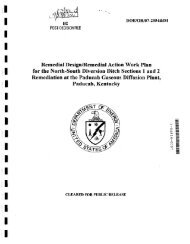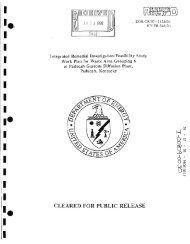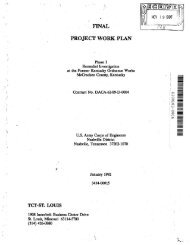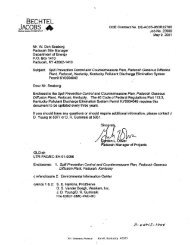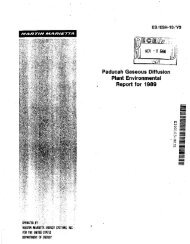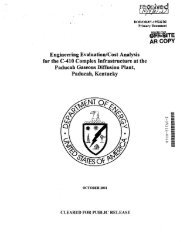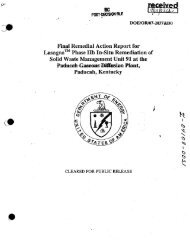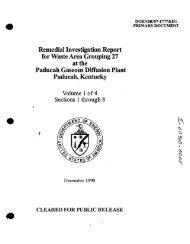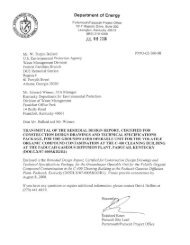1 - paducah environmental information center
1 - paducah environmental information center
1 - paducah environmental information center
You also want an ePaper? Increase the reach of your titles
YUMPU automatically turns print PDFs into web optimized ePapers that Google loves.
Annual Site Environmental Report for 1999<br />
are installed to monitor groundwater in the<br />
terrace gravels. A summary of the maximum<br />
results for each of the wells is provided in Table<br />
9.4. Complete results of the monitoring were<br />
reported semi-annually in the FFA Semiannual<br />
Progress Report.<br />
Federal Facility Agreement Monitoring<br />
The FFA requires monthly sampling of<br />
residential wells potentially affected by the<br />
contaminant plume (DOE 1998). Currently,<br />
only three residential wells (R2, R294,and<br />
R302) meet this criterion. Eighteen other<br />
residential wells' are monitored semiannually per<br />
the FFA. Additionally, MW 66 (located on site<br />
at the northwest corner of the plant) is required to<br />
be sampled on a monthly basis. All monthly<br />
sampled wells were analyzed for gross alpha and<br />
beta, TCE, and 99'fc. MW66 is sampled annually<br />
for uranium; it was not detected in 1999. As<br />
stated previously, the hydrologic unit in which<br />
residential wells are screened is uncertain;<br />
however, most are believed to be RGA wells.<br />
Table 9.5 provides a summary of the maximum<br />
detected results for the monthly monitoring<br />
programs. Semiannual residential sampling<br />
results yielded no detections of TCE and 99'fc.<br />
Two residential wells, R424 and R432, are<br />
also sampled semiannually. These wells contain<br />
TCE in the groundwater above the action limit of<br />
1 J.1g/L, however, their location makes it highly<br />
improbable that the contaminants migrated from<br />
the Paducah Site. For these wells, DOE has<br />
provided' the residents with a carbon filtering<br />
system to' allow them to have safe drinking<br />
. water. These filters are replaced semiannually<br />
and: sampled before and after filter replacement.<br />
All residents were notified by mail 01 the results.<br />
AdditionaHy, D0Esampied the<br />
groundwater wells of 23 residents that requested<br />
special sampling of their wells during 1999.<br />
These residents were also notified by mail of the<br />
results.<br />
Environmental Surveillance Monitoring<br />
Environmental surveillance monitoring is<br />
defmed as perimeter exit pathway monitoring<br />
and off-site water well monitoring. Environmental<br />
surveillance monitoring is conducted in support<br />
of DOE Orders and other laws and regulations as<br />
addressed in the Paducah Gaseous Diffusion<br />
Plant Environmental Monitoring Plan (BJC<br />
199'8). Specific wells monitored for<br />
<strong>environmental</strong> surveillance are as follows:<br />
• Annual Monitoring Program -<br />
(UCRS) MWs 96, 180, 182, and 192;<br />
(RGA) MWs 71, 106, 134, 155, 156,<br />
161, 163, 168, 169, 175, 178, 188, 191,<br />
193, 200, 201, 203, 205, and 206;<br />
(McNairy) MW 133;<br />
• Annual Background Monitoring<br />
Program - (Terrace Gravels) MW 196;<br />
(Eocene Sand) MW 305; (RGA) MWs<br />
103, 150, 194, and 199; (McNairy) MWs<br />
102, 120, 121, 122; and<br />
• Quarterly Monitoring Program -<br />
(UCRS) MWs 166, 174, 186, and 187;<br />
(RGA) MWs 20, 63, 65, 98, 99,100,125,<br />
135, 139, 146, 152, 165, 173, 185, 197,<br />
202, 260, 261, 262, 328, 329, 333, 337,<br />
338, 339, 340,341, 342, 343, 345, 346,<br />
347,352, 353, 354, and 355; (McNairy)<br />
MW 356; (Rubble Zone) MWs 345, 346,<br />
and 347.<br />
During 1999, surveiilance wells were<br />
sampled for VOCs, gross alpha and beta activity,<br />
and, '»fc. One well, MW 352, was unable to be<br />
sampled'underthe routine program due to a high<br />
solids content. Special sampling indicates that<br />
MW 352 was not adequately developed to allow<br />
proper sampling. Table 9.6 provides a summary<br />
of the maximum detected results for each<br />
hydrogeologic unit sampled for the surveillance<br />
program. The maximum TCE value reported in<br />
the RGA is 220,000 J.1g/L from MW 156. MW<br />
156 is located at the southeast corner of C-400.<br />
Groundwater<br />
9-15



